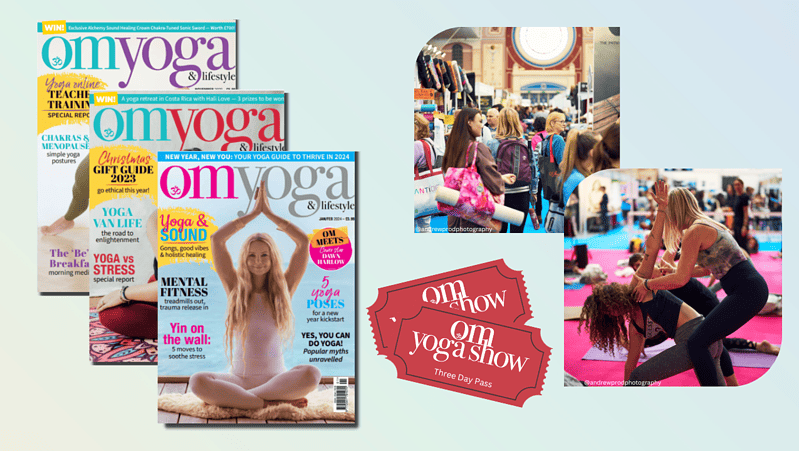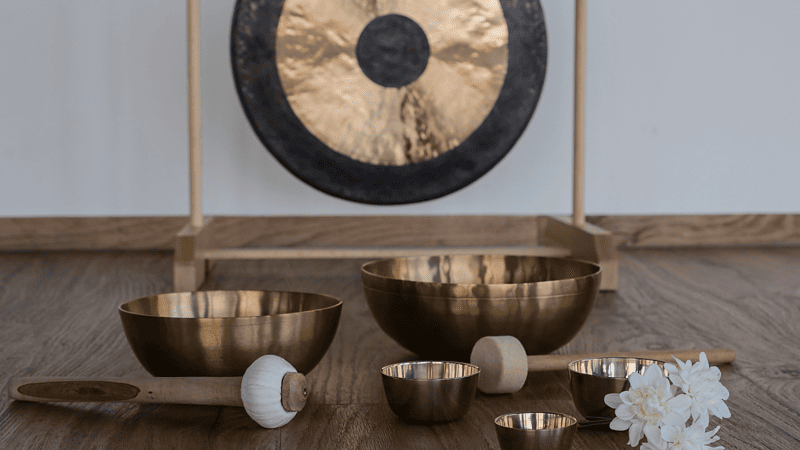A simple, gentle but very powerful yoga practice that can transform your life. By Emma Després
When I first ventured out to Byron Bay in Australia to immerse myself in yoga a year into my practice, I shall never forget my first two-hour yoga session (the normal length of the classes out there at that time). While I loved every single minute of the asana practice, the problem came with the 20 whole minutes of quiet relaxation at the end of the class. Proper quiet, that is, with no music, no distraction, nothing. Those were the longest 20 minutes of my life, or so it seemed in that moment.
Still, with me attending these two-hour sessions once or twice a day every day for a month and unable to leave the class early (many teachers will understandably discourage you from doing so), I quickly developed my own way of dealing with the mental chatter. I imagined in my mind a train line with open trucks in which I placed each of my thoughts and then watched them pass by, one after the other, until I was able, eventually, to experience some relief from the constant background mental chatter.
Over the next year I practiced a lot of yoga as I developed my practice both on and off the mat, qualifying as a yoga teacher in the process. My ability to relax improved hugely, but it wasn’t until I assisted on a teacher training course at Govinda Valley, Sydney, that I discovered the joy and, indeed, benefit of Yoga Nidra. The relaxation became something I enjoyed rather than something that I endured at the end of a class.
I can still remember the experience of that first Yoga Nidra clearly. There we were, the whole class of students, lying comfortably in Corpse Pose, a bolster under the knees and a blanket covering each of us to keep us warm. The teacher’s gentle voice soothed us into a state of cosy bliss as we relaxed each part of our body, part-by-part, experiencing sensations and bringing awareness to the natural breath; it was a journey like no other I had experienced previously.
Time lost all meaning. What was actually 30 minutes felt like five, and before we knew it we were back in the room, on our mats, in our bodies, feeling much more centred and grounded than at the beginning of the class. What was also noticeable was that the mental chatter had eased. I had managed to drift beyond it into that wonderful state of being between being awake and asleep, the hypnotic state, where real healing takes place. I felt brighter, lighter, rested and renewed.
Setting a Sankalpa
Essentially Yoga Nidra is a powerful meditation technique inducing complete physical, emotional and mental relaxation. During Yoga Nidra, one appears to be asleep but the consciousness is functioning at a deeper level of awareness so that you are prompted throughout the practice to say to yourself mentally, “I shall not sleep, I shall remain awake”.
Before beginning Yoga Nidra you make a Sankalpa or a resolution for the practice. The Sankalpa is an important stage of Yoga Nidra as it plants a seed in the mind encouraging healing and transformation in a positive direction. The Sankalpa is a short positive mental statement established at the beginning of the practice and said mentally to yourself in the present tense, as if it had already happened, such as, “I am happy, healthy and pure light”, or “I am whole and healed”.
A Sankalpa can also be used to encourage you to let go of something in your life like smoking or overeating, focusing on the underlying feeling that leads you to smoke or to overeat. For example: “I love and care for myself and my body”, or “I choose to eat foods that support my health and wellbeing” or “I am relaxed and contented”. In fact, simply having the opportunity to establish a Sankalpa is powerful in itself as it gives you a focus and enhances your awareness of self.
It is actually in connecting with yourself that you come to realise all the deep-seated tensions that Yoga Nidra helps you to release. These are all the unconscious and unresolved issues that are playing a role in some of the unwanted habits and behaviour patterns you are noticing consciously. This is the stuff that goes through your mind time and again, the stuff you resolve to change at the beginning of each year – but that ‘will’ alone will not change. What you need to do is get to the root of the problem and Yoga Nidra provides you with a means to do this.
With all the letting go of this ‘stuff’, such as trapped emotions and feelings, you become lighter and there is more energy available to be used in a more positive manner. Plus, with the power of intention in the form of a Sankalpa, that which we attract into our life also changes. It is in this way that Yoga Nidra offers us so much potential for transforming our lives in an even more positive direction than we can ever imagine.
Physical benefits
Of course, let us not forget the physiological benefits too, such as lowering of the heart rate and blood pressure, the release of lactate from the muscles that can cause anxiety and fatigue, a more restful night’s sleep and, ultimately, a calming and unwinding of the nervous system, which is basically the foundation of the body’s wellbeing. So our physical health and sense of wellbeing can improve too.
Over the years Yoga Nidra has helped me in so many ways. At times of crisis, when I have been tired and exhausted, sick and stressed, it has helped to restore, renew and heal me. At confusing times in my life when I have been unclear of the way forward, it has provided me with much-needed clarity. At other times it has helped me to let go of unhealthy addictions and behaviour patterns. The most profound was changing my relationship to myself, enabling me to effortlessly let go of the need to smoke tobacco after so many years of battling with this nicotine addiction.
These days relaxation comes easily to me and I positively seek out and embrace any opportunity for Yoga Nidra for it is just such an amazing practice. In this stressful and fast-paced world, we live in, where we can feel so disorientated and fragmented, it really helps to bring us back together and connect with ourselves again. Needless to say, I cannot promote the benefits of Yoga Nidra enough. But of course you cannot benefit from merely intellectualising; reading about it will not necessarily change things. What we really need to do is make a commitment to take the time out for ourselves. Lie comfortably, cover yourself with a blanket, close your eyes and allow yourself to be guided through a Yoga Nidra session. I doubt you will regret it, in fact, you may find it a life-changing experience.
Emma Després is the founder of Be Inspired (beinspiredby.co.uk)







